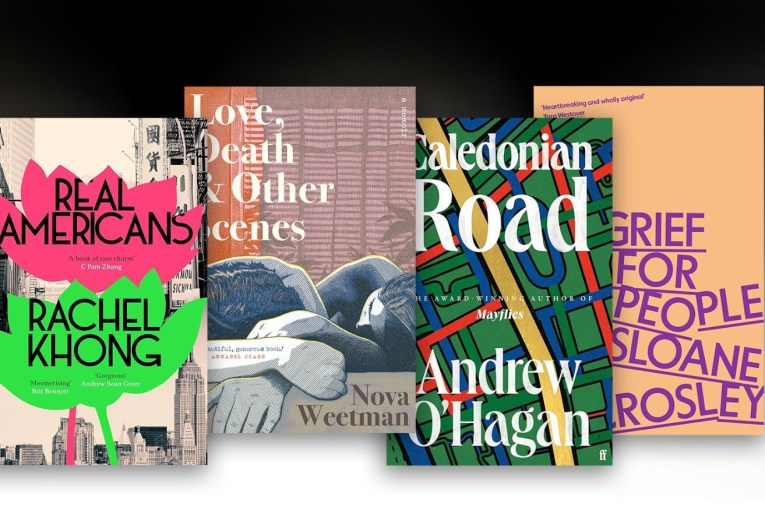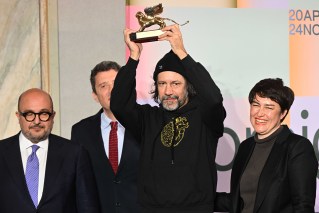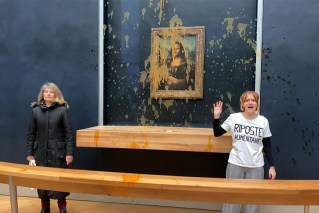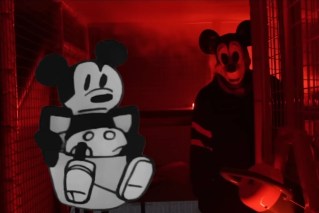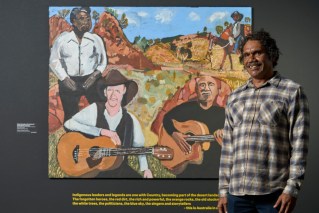Wildlife Photographer of the Year: Two Australians among winners
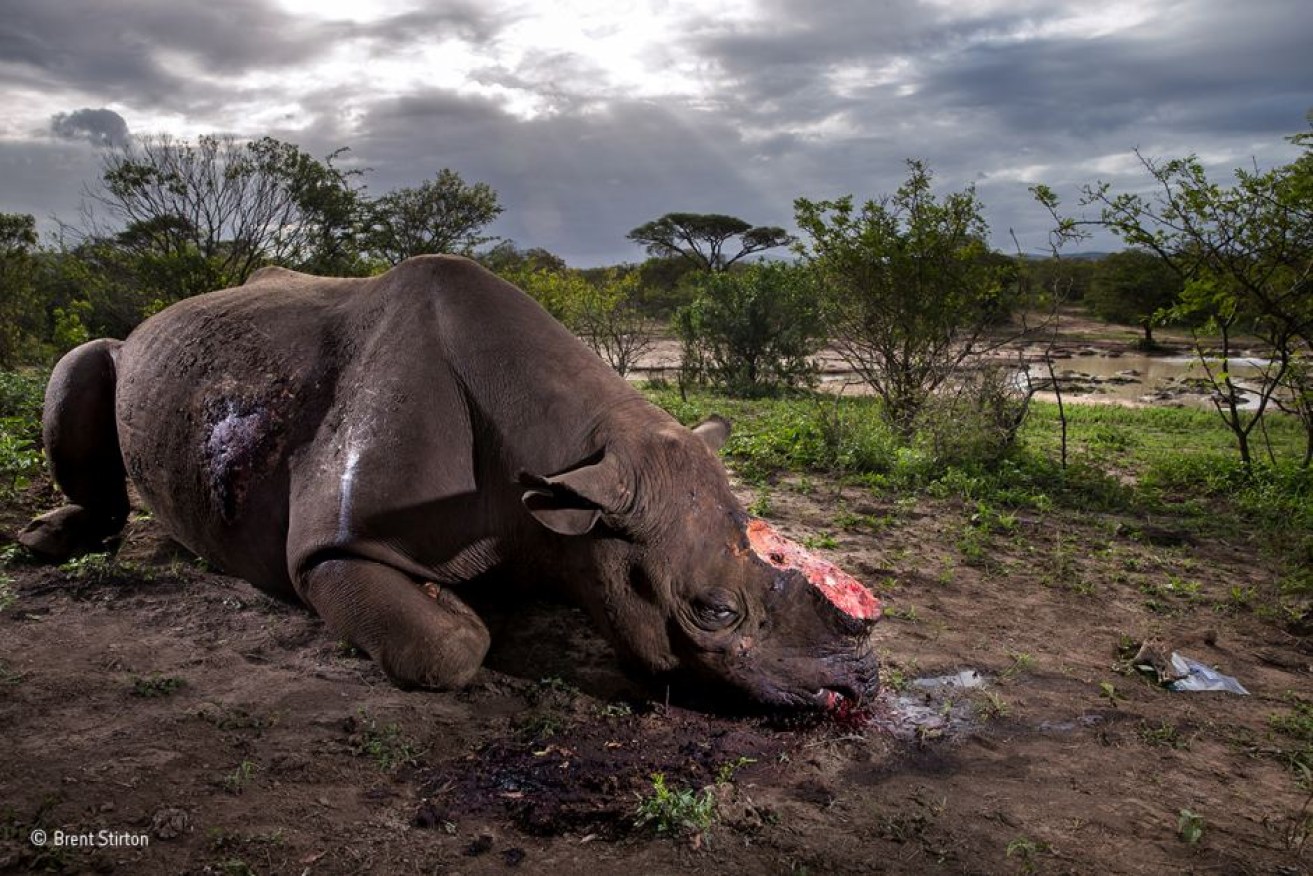
This image of a black rhino lying with its horns cut off was the overall winner of the competition. Photo: Brent Stirton
A striking image of a recently shot and dehorned black rhino has won the most prestigious prize at this year’s Wildlife Photographer of the Year competition, where two Australians were also among those commended for their work.
The winners of the Wildlife Photographer of the Year competition were announced at a ceremony at the Natural History Museum in London, which runs the annual competition.
Australian photographers won two categories and three other Australians were finalists in the competition, which received almost 50,000 entries from 92 countries.
One hundred images will be on display at the 53rd Wildlife Photographer of the Year exhibition, which will visit Sydney next May.
See all of the category winners below:
The good life: Winner, 15-17 years old

Western lowland gorilla Caco feasts on a fleshy African breadfruit in Odzala National Park. Photo: Daniel Nelson
Daniel Nelson, from the Netherlands, met Caco in the forest of Odzala National Park after a three-hour trek in the Republic of Congo.
Western lowland gorillas are critically endangered, threatened by illegal hunting for bushmeat, disease, habitat loss and the impact of climate change.
The judges commended Daniel for capturing the “inextricable similarity between these wild apes and humans and the importance of the forest on which they depend”.
Stuck in: Winner, 11-14 years old

An American red fox foraging for food beneath the snow in Yellowstone National Park. Photo: Ashleigh Scully
Deep snow had blanketed the Lamar Valley in Yellowstone National Park, US, and this female American red fox was hunting beside the road.
Ashleigh Scully, who has been photographing foxes for many years, said she found it “funny but also humbling to observe how hard the fox had to work to find a meal”.
She said the image illustrates “the harsh reality of winter life in Yellowstone”.
The grip of the gulls: Winner, 10 years and under

Herring gulls swarm down after food off the coast of central Norway. Photo: Ekaterina Bee
During a boat trip off the coast of central Norway, five-and-a-half-year-old Ekaterina Bee photographed a cloud of herring gulls that followed the small boat as it left the harbour.
Of all the many pictures the Italian took that day, this was the one she liked best because of the way the birds filled the white sky and the expression on the face of the bird furthest away.
“It looked very curious, as if it was trying to understand what was happening on the boat,” Ekaterina said.
Contemplation: Winner, Animal Portraits

Totti the chimpanzee lies down after unsuccessfully trying to court a female chimp in Uganda’s Kibale National Park. Photo: Peter Delaney
Peter Delaney had spent a long, difficult morning tracking chimpanzees through Uganda’s Kibale National Park when he came across Totti.
For more than an hour, Totti the chimpanzee had posed, gestured and called to entice one particular female down from the canopy, but nothing worked.
The object of his desire ignored him, and he eventually gave up and flopped down on the ground.
“He lay back, hands behind his head, and rested for a moment, as if dreaming of what could have been,” Mr Delaney said.
Crab surprise: Winner, Behaviour: invertebrates

A Maori octopus descends on a mass aggregation of giant spider crabs. Photo: Justin Gilligan
Justin Gilligan was busy documenting a University of Tasmania kelp transplant experiment when out of the blue, an aggregation of giant spider crabs the size of a football field wandered past.
Known to converge in their thousands elsewhere in Australian waters, such gatherings were unknown in Mercury Passage off the east coast of Tasmania.
About 15 minutes later, Gilligan noticed an “odd shape in the distance, moving among the writhing crabs”: a Maori octopus, that despite being being the biggest octopus in the southern hemisphere, was having trouble catching a crab.
Mr Gilligan also won the Australian Geographic Nature Photographer of the Year competition for a different photo of this hungry octopus.
The incubator bird: Winner, Behaviour: birds

A male Australian bush turkey adds more insulation to raise the temperature of his mound. Photo: Gerry Pearce
Gerry Pearce captured this male brush turkey near his home in Sydney, bordering Garigal National Park, after four months of watching it maintain its nest.
The Australian brush turkey is one of a handful of birds, known as megapodes, that incubate their eggs with an “oven” instead of with their own bodies.
In this picture, the turkey is piling more insulation onto its mound to raise the temperature.
The ancient ritual: Winner, Behaviour: amphibians and reptiles

A female leatherback turtle moves steadily back to the ocean at Sandy Point. Photo: Brian Skerry
It took two weeks for Brian Skerry to get the leatherback turtle encounter he wanted at Sandy Point National Wildlife Refuge on St Croix, in the US Virgin Islands.
Leatherbacks are the largest, deepest-diving and widest-ranging sea turtles, the only survivors of an evolutionary lineage that diverged from other sea turtles 100-150 million years ago.
Judges commended Skerry’s work for “artfully evoking a primordial atmosphere in this timeless scene”.
Giant gathering: Winner, Behaviour: mammals

Dozens of sperm whales mingle off Sri Lanka’s north-east coast. Photo: Tony Wu
Dozens of sperm whales mingled noisily off Sri Lanka’s north-east coast, stacked as far down as Tony Wu could see.
Sperm whales groups play, forage, interact and communicate in different ways and have distinctive cultures; aggregations like this could be a critical part of their rich, social lives but are rarely reported.
By continually swimming to reposition himself and the tolerance of the whales themselves, Wu got a unique photograph of the mysterious Indian Ocean gathering.
The ice monster: Winner, Earth’s Environments

A group of divers surround a section of the ice shelf in east Antarctica. Photo: Laurent Ballesta
When Laurent Ballesta, from France, spotted this relatively small iceberg, he saw the chance to realise a long-held ambition – to show for the first time the underwater part.
The image is the result of 147 images stitched together, and it took three days in virtually freezing water to capture the entire scene.
“None of us could see the whole thing under water. Close to, it was overflowing from our view. From a distance, it disappeared into the fog,” Ms Ballesta said.
The night raider: Winner, Animals in their Environment

An anteater attacks a termite mound covered in bioluminescent click beetle larvae. Photo: Marcio Cabral
For three seasons, Marcio Cabral had camped out in Brazil’s Cerrado region, waiting for the right conditions to capture the light display that happens when winged termites take to the sky to mate.
After days of rain, Mr Cabral was finally able to capture the phenomenon, but he also got a surprise bonus.
Out of the darkness ambled a giant anteater, which began to attack the tall, concrete-mud mound with its powerful claws, going after the termites living deep inside.
Polar pas de deux: Winner, Black and White

A polar bear and her cub stand with their back legs pressed together in Arctic Norway. Photo: Eilo Elvinger
From her ship anchored in the icy waters off Svalbard, in Arctic Norway, Eilo Elvinger of Luxembourg spotted a polar bear and her two-year-old cub in the distance, slowly drawing closer.
When they drew closer to the ship, they began to lick a patch of snow soaked in leakage from the vessel’s kitchen.
“I was ashamed of our contribution to the immaculate landscape, and of how this influenced the bears’ behaviour,” Ms Elvinger said.
Tapestry of life: Winner, Plants and fungi

The ranges in Norway’s Lofoten Islands are covered in a mountain variety of downy birch. Photo: Dorin Bofan
It was a quiet morning with flat light as Dorin Bofan, from Romania, stood alone on the shore of the fjord.
He was contemplating the immense landscape bounding Hamnoy in the Lofoten Islands, Norway, when the clouds parted, allowing shafts of sunlight to fall on to the great walls of metamorphic rock, lighting up the swathes of vegetation coating the canyon and its slopes.
The judges described the work as “a brief moment in a timeless landscape, cloaked in a tapestry of Arctic-alpine vegetation”.
The jellyfish jockey: Winner, Underwater

A small lobster larva clutches on to a mauve stinger jellyfish in open ocean off Tahiti. Photo: Anthony Berberian
Anthony Berberian regularly goes diving more than two kilometres deep in open ocean far off Tahiti, French Polynesia, with the aim of capturing tiny deep-sea creatures.
This lobster larva (on top), just 1.2 centimetres across, with spiny legs, a flattened, transparent body and eyes on stalks, was at a stage when its form is called a phyllosoma.
The pair were drifting in the current, the phyllosoma saving energy and possibly gaining protection from predators deterred by the jelly’s stings, its own hard shell probably protecting it from stings.
Palm-oil survivors: Winner, Single image

Three generations of Bornean elephants edge their way across a palm oil plantation in eastern Sabah. Photo: Aaron Gekoski
When Aaron “Bertie” Gekoski saw three generations of Bornean elephants in eastern Sabah, the light was fading fast, and he needed to act quickly.
The elephants were edging their way across the terraces of an oil-palm plantation being cleared for replanting, and Mr Gekoski wanted to frame an image that symbolised the impact that demand for palm oil has on wildlife.
“They huddled together, dwarfed by a desolate and desecrated landscape. A haunting image,” he said.
